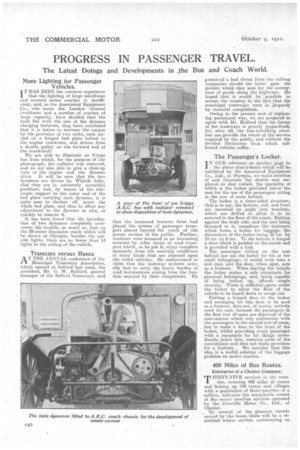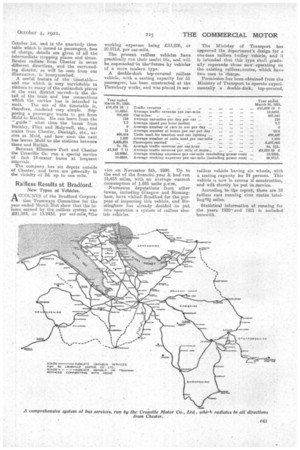PROGRESS IN PASSENGER TRAVEL.
Page 28

Page 29

If you've noticed an error in this article please click here to report it so we can fix it.
The Latest Doings and Developments in ,the Bus and Coach World.
More Lighting for Passenger Vehicles.
I T HAS BEEN the common experience
that the lighting of large omnibuses and covered motor coaches is insufficient, and, as the Associated Equipment Co., who make the London General omnibuses and a number of coaches of large capacity, have decided that the fault lies with the size of the dynamo charging batteries they have concluded that it is better to increase the output by the provision of two units, each carried on a hinged bed plate bolted to the engine crankcase, 'and driven from a double pulley on the forward end of the Crankshaft.
We are able to illustrate an S-type bus from which, for the purpose of our photograph, the radiator -was .rmoved,, and we are also able to give a close-up view of the engine and the dynamo drive. It will be seen that the two dynamos are driven by Whittle belts, that they are in extremely accessible positions, and, by means Of the telescopic support to the outer end of the bed plate carrying each dynamo, it is quite easy to slacken off, lower the whole bed plate, and then to effect any adjustment to the dynamo in situ, or quickly to remove it.
It has been found that the introduction of two dynamos completely overcomes the trouble, so much so, that on the al-seater limousine coach which will be shown at Olympia, besides the outside lights, there are no fewer than 14 lights in the ceiling of the vehicle.
Tramcars versus Buses.
AT THE ANNUAL conference of the Municipal Tramways Association, .Which opened at Salford last week, the president, Mr. G. W. Holford, general manager of the Salford Tramways, said
that the increased tramcar fares had placed the system of passenger transport almost beyond the reach of the poorer section of the public. Further, tramcars were menaced in an increasing: measure by other forms of road transport which, as he put it, enjoy complete immunity from the exacting conditions of many kinds that are imposed upon the railed vehicles. He endeavoured to claim that the tramway systems actis. ally had to carry the heavy burden of road maintenance arising from the freedom enjoyed by their competitors. He perceived a bed threat from the railway companies should the latter gain the powers which they seek for the conveyance of goods along the highways. He hoped that it would be possible to arouse the country to the fact that the municipal tramways were in jeopardy by wasteful competitioh.
Owing to the present cost of replacejug permanent way, we are prepared to agree with Mr. Holford that the future of the tramways is greatly jeopardized, for, after all, the free-travelling omnibus can provide the whole of the service required by the public, and without the decided limitations frem which railbound vehicles suffer.
The Passenger's Locker.
I N OUR reference on another page to the motor char-a-bancs which will be exhibited by the Associated Equipment Co., Ltd., at Olympia, we make mention of and illustrate the double seat employed on that vehicle, the speciality of which is the locker provided below the seat for the use of the passenger's sitting in the row of seats behind.
The locker is a three-sided structure, that is to say, the bottom, end, and front are mounted on angle iron brackets, which are drilled to allow it. to be screwed to the floor of the coach. Butting against the body side, and the seat being fastened to it, completes the enclosure which forms a locker for luggage, the dimensions of the locker being 32 ins. by 14 ins. by 8 ins. To the bottom is hinged a door which is padded on the, inside and is provided -with a lock.
The passenger sitting on the seat behind can use the locker for his or her small belongings; it. would even take a suit case, and the door, when open, acts as a footrest.. When leaving the vehicle the locker makes a safe receptacle for personal belongings, and, being capable of being locked up, affords ample security. There is sufficient.space under the locker to allow the floor of the vehicle to be hosed down or swept out.
Putting a hinged door to the locker and arranging for this door to be used as a footrest, does not, of course, entirely meet the case,' because the passengers in the first row of-seats are deprived of the convenience which only commences with the passengers in the second rowof seats, but to make a door to the front of the locker, whilst providing every passenger with a receptacle for his things immediately below him, removes some of the convenience and does not make provision for a footrest. We consider that this idea is a useful solution of the luggage problem on motor coaches..
408 Miles of Bus Routes.
Enterprise of a Chester Company. • rfHIRTY-FIVE servicesin six coun: ties, covering 408 miles of routes and linking up 150 towns and villages with a population of three-quarters of a million, indicates the remarkable extent of elle motor omnibus services operated by the Crosville Motor Co., Ltd., of Chester.
-. To several of the pleasure resorts served by the buses there will be a restricted winter service, commencing on October 1st, and in the quarterly timetable which is issued to passengers, free of charge, details are given of all the intermediate stopping places and times. Routes radiate front Chester in seven different directions, and the surrounding district, as will be seen from our illustration, is honeycombed. A useful feature of the timetable—. and one which is very serviceable to visitors to many of the outlandish pldces in the vast district served—is the detail of the train and bus connections which the service bus is intended to Meet. The use of the timetable is, therefore, rendered very simple. Supposing a passenger wants to get from Mold to Ruthin. He can learn from the
guide " what time the buses' from Buckley, Flint and Holywell, etc., and trains from Chester' Denbigh, etc., arrive at Mold, and how soon the next bus leaves Mold to the stations between there and Ruthin.
Between Ellesmere Port and Chester the Crosville Co. run a special service of fast 14-seater buses at frequent intervals.
The company has six depots outside of Chester, and fares are generally in the vicinity of 2d. up to one mile.
Railless Results at Bradford.
New Types of Vehicles.
A CCOUNTS of the Bradford Corpora
tion Tramways Committee for the year ended March 31st show that the income earned by the railless system was 221,384, or 13.243d. per car-mile, the working expenses being £33,226, or 20-571d. per car-mile.
The present railleas vehicles have practically run their useful life, and, will be superseded'in the•future by vehicles of a more modern type.
A double-deck top-covered Tailless vehicle, with a seating capacity for 51 passengers', has been constructed at the Thornbury works, end was placed in ser vice on November 6th, 1920. Up to the end of the financial year it, had run 15,453 miles, with an average. 'current consumption of 1.685 units' p.e.m., Numerous deputations from other towns, including Glasgow and Birmingham, have visited Bradford for the purpose of inspecting this vehicle, and Birmingham has already decided to put into operation a system of railless electric vehicles.
The Ministry of Transport has approved the department's design for a one-man railless trolley vehicle, and it is intended that this type shall gradually supersede those now operating on the existing raillessocutes, which have two men in -Charge.
Perinissionlas beencbtained from the Ministry of Transport to operate experimentally a double-deck, top-covered,
railless vehicle having. six wheels, with a seating capacity Lox 57 persons. This vehicle is now 'in -course of construction, and will, shortly be.put in.service.
According to te report, there are 18 railless cars running over routes totallingi% Statistical information of running for the years 1920 and 1921 is included herewith.
















































